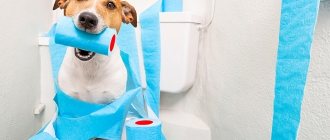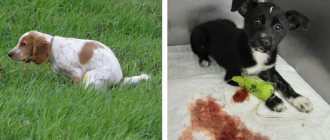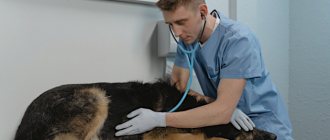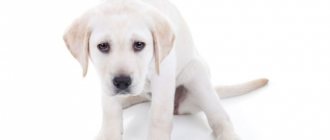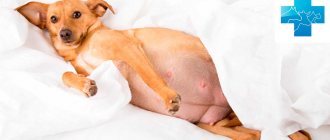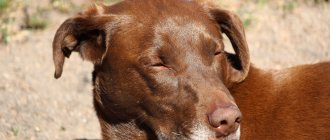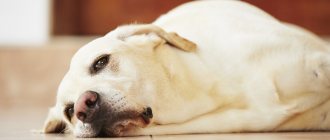It happens that a beloved pet suddenly changes mood, and soon it turns out that the dog has diarrhea. This condition may be considered a minor problem, but in fact, sometimes it is an indicator of some deviations in the health of the shaggy friend. Below you will learn in detail about the symptoms of diarrhea in a dog and learn how to treat it at home.
Symptoms of diarrhea in a dog
global $ads_google; //data-ad-slot=”2475549904″ $ads_google = empty($ads_google) ? false : true; ?> if ($ads_google == false) {?>
$ads_google = true; ?> } ?>
Diarrhea in a dog is considered to be liquid stool; feces may simply be watery. What exactly is defined as diarrhea?
- Liquid stool;
- Frequent bowel movements in small volumes (up to 4 times a day);
- The stomach is “seething”;
- It is painful for the animal to defecate, it begins to whine or moan;
- Behavior becomes agitated or apathetic and lethargic.
Sometimes other symptoms of diarrhea in a dog are added to the above:
- The color of the stool may change;
- There is blood and mucus in the feces;
- Repeated foamy or regular vomiting is added;
- Temperature readings are either high or, conversely, very low;
- The excrement smells very bad;
- The dog refuses to drink or, on the contrary, experiences frequent excessive thirst.
The main causes of loose stools
Every problem has a root cause. If your dog has diarrhea, there may be several reasons:
- The food chosen is of poor quality or completely unsuitable for the pet.
- The usual type of food has changed dramatically due to the fault of the owner. Different breeds have their own types of nutrition.
- Helminthic infestations.
- The dog is sick with parvovirus enteritis, adenovirus, rotavirus, coronavirus, an atypical form of rabies, and fungal diseases.
- The walls of the stomach and intestines can be damaged if the animal swallows a foreign object or bone.
- The body reacted in this way to antibiotics.
- The animal has dysbiosis or neoplasms.
- Diarrhea in a dog can be caused by chemical poisoning or an allergic reaction to foods or medications.
- Stress is also a significant factor in the occurrence of diarrhea.
Poor quality food
Much more often, the cause of mucous diarrhea is simply poor quality, spoiled food . And it goes to dogs really often.
Firstly, these animals have an unpleasant habit of digging in any available garbage heap, where there may well be remnants of spoiled and discarded food.
Secondly, many inexperienced and overly “frugal” breeders feed expired food to their pets (which is strongly not recommended).
Interesting! There is an opinion that the digestive system of dogs is very “strong”, but this is not entirely true. They can indeed eat “tasty” meat without any consequences, but this does not apply to rotten food.
If you regularly feed your dog the stale contents of your refrigerator, do not be surprised that your pet will regularly smear mucous masses. What’s even worse is that the kidneys and liver suffer greatly from such “delicacies.” But there are more dangerous causes of diarrhea with mucous inclusions.
How long can diarrhea last?
Prolonged diarrhea in a pet will alert anyone. But the concept of “long-term” is flexible. If the causes of diarrhea are natural, then it will end in the next 24 hours without causing significant discomfort.
It happens that a dog has loose stools more than 4 times a day, or it lasts for more than 2 days. Here there is already a serious danger of dehydration.
Sometimes diarrhea is prolonged and lasts up to a week. This is an indicator that the cause is bacterial in nature and time is needed to eliminate it. This is the very case when contacting a veterinarian is mandatory.
The manifestation of chronic diarrhea is due to various reasons. If you notice such a feature of your dog’s body, consult a specialist. This could be a sign of an allergy or a reaction to stress.
The dog has a bloated belly and diarrhea
There is simply bloating with diarrhea. The reasons are trivial, a healthy animal defecates up to 4 times a day with moderately moist and soft feces. When feces lose their shape and become watery, this is diarrhea, which could be caused by poor nutrition, switching to a different type of food, changing the brand of food, or an allergic reaction. The dog could also have swallowed an object or have worms.
What to do
First you need to do a nutritional analysis. If a suspicious eaten product is discovered: raw meat, sour milk, low-quality or unsuitable product, then it is removed from the menu.
If the dog has overeaten, this is a signal to reduce the portion or increase the interval between meals. In this case, diarrhea will not bother the dog much.
When, despite the measures taken, the stool remains watery, a number of therapeutic measures are required.
- The dog should not eat anything for 24 hours, but it should be given something to drink very often. Loss of fluid in the body is a very serious matter.
- If the dog refuses to drink, we take him to the veterinarian to administer intravenous infusion solutions. At home, in case of diarrhea, you need to give adsorbents that will help collect and remove toxic substances and poisons.
- Prolonged loose stools are treated with antibiotics.
The dog has diarrhea with blood and/or mucus
global $ads_google; //data-ad-slot=”2475549904″ $ads_google = empty($ads_google) ? false : true; ?> if ($ads_google == false) {?>
$ads_google = true; ?> } ?>
A scary situation is when a dog has bloody diarrhea and/or mucus in the stool. We don’t wait, but take the pet to the veterinary clinic for examination. Immediate assistance will be provided there.
The probable cause may be mechanical damage to the intestinal walls or tumor. Only surgery will help here.
A blood test will show whether there is anemia and what could be the beginning of the inflammatory process. There they will take stool for analysis and take an x-ray of the abdominal cavity.
The cause can also be diseases of the gastrointestinal tract, parasites, an atypical form of rabies, poisoning, bleeding in the large intestine, and distemper. To identify the true cause and eliminate it, you need to conduct an examination.
What to do if you have bloody diarrhea
The alarming symptom of blood in liquid stool may disappear on its own, for example, if the process is caused by scratches on the inner walls of the intestines. And it can lead to disastrous results.
After the examination, the doctor will prescribe a number of therapeutic measures. If surgery is not required, the dog will be prescribed wound healing agents.
Poisoning is treated by gastric lavage right in the clinic, taking adsorbents, and antibiotic injections.
Dysbacteriosis is eliminated by adding fiber to the diet, for example, bran. The introduction of probiotics will be required, antiseptics and immunomodulators will help.
Helminthic infestations of any nature are treated with antiparasitic agents, such as milbemax, makmiror, albendozole.
Briefly about the main thing
- Diarrhea, also known as diarrhea, is a symptom and not a separate disease.
- Chronic diarrhea is more dangerous because... may lead to death.
- If blood appears in the stool, contact your veterinarian immediately.
- Vomiting in symbiosis with diarrhea leads to severe dehydration; without timely assistance, the animal will die.
- The color of feces indicates pathological changes in organs.
- Treatment is carried out comprehensively, sometimes with a course of antibiotics.
- Nutrition during diarrhea is special, with plenty of water and a minimum amount of food.
Diarrhea with vomiting
If the dog begins to vomit in addition to liquid feces, then the matter takes a more complex turn. Along with liquid masses, digested and undigested food, mucus from the pharynx and stomach leave the body.
If the vomiting is one-time, then there is no need to worry for now. But if it’s repeated, then we watch the pet very carefully.
When a pet vomits several times, it becomes depressed, may refuse to eat, the temperature rises - we immediately go to the veterinarian.
Diarrhea with vomiting in a dog is often a symptom of a dangerous illness or poisoning. Especially if the mass contains foam, particles of blood, and mucus. This indicates that there may be a foreign object in the intestines.
If vomiting occurs once during diarrhea, overeating or excessively fatty, stale food may be to blame.
When there is chemical poisoning, shortness of breath is added to the vomit and loose stools, drooling profusely, and the stomach will be hard to the touch.
A symptom of poisoning with toxic poisons due to helminthiasis will be a sharp loss of weight and nausea immediately after eating.
Diarrhea with vomiting is observed with parvovirus enteritis, or otherwise canine distemper. In this case, discharge from the nose and eyes, heart rhythm disturbances, and fading of the animal will be observed.
It has been noted that the symptoms of rotavirus and coronavirus are similar, but recovery usually occurs a week after the onset of the disease. With adenovirus, in addition to diarrhea and vomit, the temperature will fluctuate from normal to high degrees, and inflammation will be noticeable in the mucous membranes of the eyes. The animal is sick for up to two weeks, the liver enlarges.
What to do if your dog has loose stools and vomiting
global $ads_google; //data-ad-slot=”2475549904″ $ads_google = empty($ads_google) ? false : true; ?> if ($ads_google == false) {?>
$ads_google = true; ?> } ?>
Treatment is prescribed depending on the disease and its symptoms.
If vomiting occurs once or even three times, you can take measures as with typical diarrhea without complications. That is, the dog is not fed for a day, given clean fresh water, but in small doses, and adsorbents (activated carbon, smecta). If the dog is in pain, no-shpu, papaverine or their analogues are administered.
The diet is required for three to five days.
Diarrhea with vomiting may recur; in this case, a water-salt solution is administered, and fermented milk is added to the menu to support the intestinal microflora. It is advisable to give probiotics.
If the cause of loose stools and vomiting is unknown, especially if it occurs multiple times, an urgent examination and blood test are required. The veterinarian will provide all the necessary assistance, establish a diagnosis, perform surgery if necessary, and flush the stomach. You cannot help a dog at home without medical experience, instruments and medications.
Unusually colored excrement
The color of a quadruped's stool depends on the food it eats. In another situation, it is worth finding out why the changes in the color of the feces occurred.
Possible factors
So, a black color can indicate dangerous bleeding from the duodenum or stomach - or be a common consequence of using activated charcoal or iron-containing drugs.
Yellow feces are a consequence of liver dysfunction, indigestion, or the presence of worms. If yellow stool causes a drop in temperature and a strong unpleasant odor, then most likely it is parvovirus enteritis.
Rarely does stool appear white. This color indicates the absence of bile in them due to blockage of the bile ducts. Blood impurities indicate the presence of intestinal injuries, severe inflammation or viral infections in the animal.
The green color of feces is associated with the process of fermentation or rotting in the dog’s intestines due to spoiled food. It also becomes a symptom of dysbiosis, gastrointestinal diseases, and the development of infections.
Treatment
What to give a dog for diarrhea of an unusual color is decided by a specialist after conducting an examination and studying the test results of the sick animal. The most commonly prescribed medications are conventional medications that are suitable for all types of intestinal disorders.
Having established the reason for the coloring of excrement in an uncharacteristic color, the veterinarian gives certain recommendations. There are a number of common uses:
- food restriction for at least a couple of hours, and preferably for a day;
- menu adjustments;
- drinking small portions;
- use of adsorbents.
Following the recommendations of a veterinarian is important not only for curing a four-legged animal. Independent selection of medications and the use of traditional methods can harm your pet. And untimely access to the clinic leads to late diagnosis of serious diseases.
Treating a dog for diarrhea at home
At home, general therapy is recommended, suitable for all types of diarrhea. But if the diagnosis is accurately established, then precise treatment with the use of medications will be prescribed.
In general, the above-described recommendations on diet, identifying the cause, drinking regularly, and taking probiotics remain relevant.
It’s important to remember ways to help prevent diarrhea in your dog:
- You should not offer your pet bones or small objects to play with. They are easy to swallow. If the dog does not choke, the object may injure the intestinal walls.
- There should be no sudden changes to the menu. If for some reason it is decided to switch to a new diet, then this transition should be gradual.
- Leftovers from the master's table belong in the trash can, not in the dog's plate!
- A sure way to intestinal upset is walking near garbage containers, as well as drinking dirty, stale water.
- While on a walk, a family friend should not help himself to dog or other feces.
- Skipping vaccinations and neglecting deworming does not lead to intestinal health, but brings with it a number of very serious problems.
- Stress is also a source of intestinal upset, so remember that we got a dog to take care of it!
global $ads_google; //data-ad-slot=”2475549904″ $ads_google = empty($ads_google) ? false : true; ?> if ($ads_google == false) {?> $ads_google = true; ?> } ?>
Prevention of the disease
In order to prevent diarrhea in your pet, you should follow some recommendations:
- Do not allow your dog to pick up food on the street, take it from strangers, wearing a muzzle if necessary, or dig through the trash can;
- Do not feed foods prohibited for animals (fatty, smoked, tubular bones, pork, etc.), do not overeat;
- Vaccinate your pet in a timely manner, as well as carry out deworming;
- Purchase only high-quality food with a valid expiration date;
- Remove small objects from the access area that the dog could swallow.
Medicines and dosage for diarrhea in dogs
The medications that a person takes for diarrhea are in most cases suitable for a four-legged family friend, even a puppy. For complete treatment, you need to consult a veterinarian.
Loperamide
Loperamide and its analogues, which are offered by different manufacturers, come first. It is unlikely that a dog will happily eat such a bitter drug, so it needs to be crushed into powder, diluted with water and given to the animal.
A sick animal may resist such a tasteless method of treatment, so first we learn how to give the pill to a dog.
Dosage 0.05-0.1 mg per 0.5 kg of dog’s body weight. Give the medicine three times a day at intervals of 8 hours. Do not give loperamide for more than two days; this will lead to poisoning. This medication cannot be combined with other drugs of similar effect! This road leads to damage to the central nervous system.
An overdose will result in very persistent constipation, an apathetic or overexcited state, severe flatulence and even inflammation of the pancreas.
Smecta
Smecta is also one of the most common remedies for digestive disorders. Purified clay medicine safely and effectively absorbs toxins. The powder is mixed with water at a ratio of 1 to 3.
The dosage is simple: a sachet per animal three times a day. You can inject the suspension with a syringe without a needle, pouring a thin stream into the mouth. At the same time, you need to lightly massage your throat, causing swallowing movements.
This method of massaging the throat is suitable for all medicines that have an unpleasant taste.
Enterofuril
A product with an antibacterial effect helps in the fight against gram-positive and negative bacteria that cause digestive system disorders. The medication should not be given on an empty stomach; the dog needs to be fed a little before taking it.
The dosage is calculated at 2.5 ml per 1 kg of body weight. The medicine is taken calmly due to its sweet and mild taste.
Activated carbon
The most famous remedy for eating disorders in humans is just as effective in dogs. A tablet obtained through special processing of certain types of wood is an excellent therapeutic agent for diarrhea.
The dosage is simple: only 1 tablet per 1 kg of weight. The drug is diluted with water to a semi-liquid pulp and given with a syringe without a needle. You can give the medicine up to 4 times a day, but not after other medications. In this case, the effect of treatment may be reduced.
Levomycetin
In addition to classic chloramphenicol, there is also chloramphenicol stearate, which is convenient in veterinary medicine for intestinal disorders due to the action of bacteria. The tablet is crushed to a powder state, mixed with 15 ml of water and poured into the pet’s throat. Can be given using a syringe.
Furazolidone
It's better to choose another
medication, if there is such an option, since the effect of this particular medication is poorly tolerated by pets. Possible side effects include jaundice, renal failure, lethargy and central nervous system depression.
Dosage: 1 tablet per day once during the treatment period. The next day they switch to more gentle means.
Enterosgel
global $ads_google; //data-ad-slot=”2475549904″ $ads_google = empty($ads_google) ? false : true; ?> if ($ads_google == false) {?>
$ads_google = true; ?> } ?>
Enterosgel sorbent was developed by Soviet pharmacists, who created a product that does not react with digestive juices and other medications. Enterosgel does not provide ideal protection of mucous membranes in case of severe poisoning.
The dosage depends on the size of the animal’s body and its weight. For a small dog weighing up to 5 kg per day, it is enough to give a teaspoon of medicine; a large dog should receive up to 3 teaspoons.
A severe overdose will lead to severe constipation. Enterosgel is diluted with boiled water at room temperature in a 1:1 ratio.
Linex
Linux doesn't cure
diarrhea in dogs, but prevents it. It contains lactic acid bacteria, which give a symbiotic effect and do not conflict with the natural microflora of the animal’s intestines.
Linex is prescribed after completing a course of antibiotics, after severe poisoning, and also after any severe diarrhea. This is due to the fact that dogs have weak intestinal microflora, and diarrhea washes away beneficial microorganisms. As a result, dysbiosis develops, further worsening the situation.
Dosage is calculated depending on weight. If the dog weighs up to 10 kg, 1 capsule is needed, if more, up to 2-3 capsules twice a day. Treatment lasts 2 weeks. The drug can be taken for a long period.
Dysbacteriosis
It should be noted that today the existence of this diagnosis is questioned by many experts, but in the case of dogs, pathology certainly exists. It's all about the structural features and physiology of the intestines in canines. Evolutionarily, it turned out that the total length of their gastrointestinal tract is quite small.
In combination with other factors, this leads to the fact that most of the beneficial microflora from the dog’s intestines is simply “washed out” with each act of defecation. It is for this reason that dogs on walks look for and eat other people’s feces... This is a kind of “health coprophagia”.
For dogs, long-term and uncontrolled use of antibiotics and other antibacterial drugs is much more dangerous than if you compare them with other animals. The microflora in their intestines is hardly killed instantly, but its restoration occurs very, very “slowly.”
If there are no beneficial bacteria, pathogenic and conditionally pathogenic microbes multiply in the intestines, which leads to inflammation and diarrhea with mucus and blood. To prevent this from happening, dogs must (!) be given probiotics after a course of any antimicrobial drug . “Human” Linex has proven itself quite well.
But if there is such an opportunity, it is much better to buy drugs in the form of a liquid fraction. There are much more living microorganisms there, and therefore their effect is much higher.
What to feed your pet with diarrhea
After the first day of therapeutic fasting, you need to wonder what to feed your suffering pet. On the first day, your pet is fed with clean water, and on the second day you can add an infusion of medicinal plants and rice water.
It is advisable to include rice boiled in water in the menu of the second and third days. As soon as the loose stool stops bothering the dog, he is treated to rice cooked in chicken or beef broth. This will help you quickly restore lost strength.
You cannot feed a lot at once, no matter how great the temptation, especially for puppies. Portions are increased gradually, as is the frequency of feeding. Feed the dog little by little, up to 6 times a day. On the second day or the day after the diarrhea has ended, you can include fermented milk products in the menu. Such food is more likely to restore the intestinal microflora.
As soon as your health improves, low-fat cottage cheese is added to your diet. On the third day, if the dog feels definitely better, he is treated to a couple of boiled eggs. White chicken meat, steamed or boiled in water, helps to restore strength.
